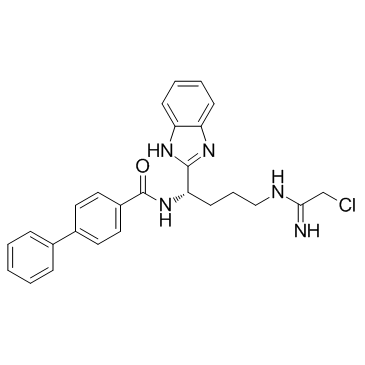1802637-39-3
| Name | BB-Cl-Amidine |
|---|---|
| Synonyms |
N-{(1S)-1-(1H-Benzimidazol-2-yl)-4-[(2-chloroethanimidoyl)amino]butyl}-4-biphenylcarboxamide
[1,1'-Biphenyl]-4-carboxamide, N-[(1S)-1-(1H-benzimidazol-2-yl)-4-[(2-chloro-1-iminoethyl)amino]butyl]- |
| Description | BB-Cl-Amidine is a peptidylarginine deminase (PAD) inhibitor. |
|---|---|
| Related Catalog | |
| Target |
PAD[1]. |
| In Vitro | Cl-amidine and BB-Cl-amidine show similar in vitro potencies and selectivities; however, the cellular potency of BB-Cl-amidine is increased by more than 20-fold, evidenced by decreased EC50 values obtained from viability studies with U2OS osteosarcoma cells (8.8±0.6 μM vs >200 μM for Cl-amidine). Cl-amidine and BB-Cl-amidine significantly inhibit NET formation by MRL/lpr neutrophils[1]. |
| In Vivo | Treatment with BB-Cl-amidine subtly reduces splenomegaly in MRL/lpr mice, while there is a trend towards increased circulating levels of anti-NET antibodies with PAD inhibitor treatment. However, neither PAD inhibitor affected body weight or total IgG levels. Indeed, treatment with both Cl-amidine and BB-Cl-amidine significantly improves endothelium-dependent vasorelaxation. The BB-Cl-amidine group also shows a strong trend towards downregulation of IRGs. Treatment with either Cl-amidine or BB-Cl-amidine significantly improves muzzle alopecia, in many cases preventing it entirely[1]. |
| Animal Admin | Mice[1] MRL/lpr mice are treated with either Cl-amidine (Cl-am; 10 mg/kg/day) or BB-Cl-amidine (BB-Cl-am; 1 mg/kg/day) by daily subcutaneous injection from 8 to 14 weeks of age[1]. |
| References |
| Density | 1.3±0.1 g/cm3 |
|---|---|
| Molecular Formula | C26H26ClN5O |
| Molecular Weight | 459.970 |
| Exact Mass | 459.182587 |
| LogP | 3.86 |
| Index of Refraction | 1.655 |
| Storage condition | 2-8℃ |
